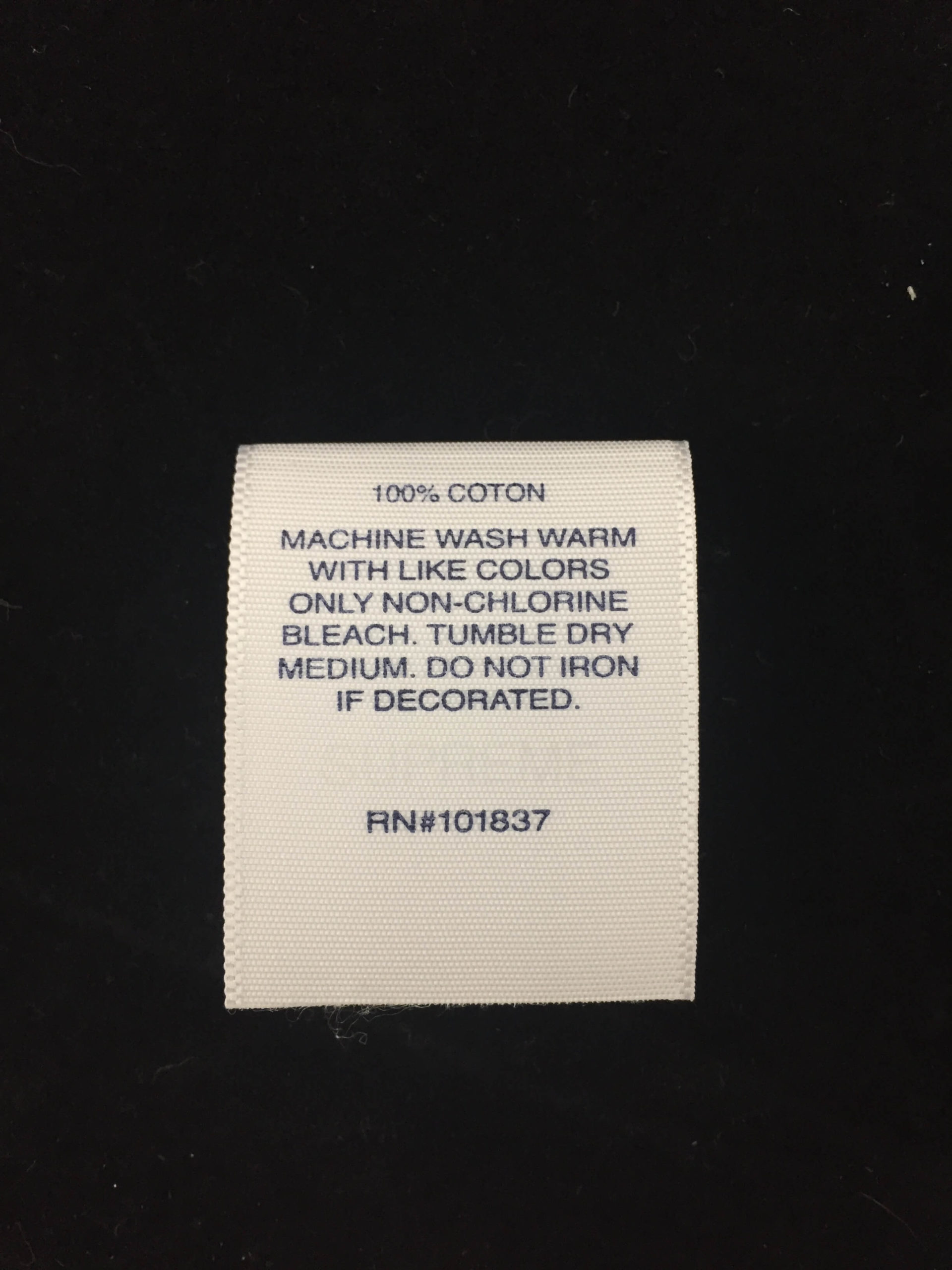39 is country of origin required on labels
Food labelling: country of origin - GOV.UK If all these activities took place in a single country, the label 'Origin: [name of country]' is acceptable. For the GB market, 'United Kingdom' is the origin label for beef and veal from both GB... › groceries › country-of-originCountry of origin | ACCC Country of origin food labels. Most of the foods you buy need to display country of origin labels. Look out for these labels on food packages or in-store signage. Different labelling requirements apply depending on: whether the food is grown, produced, made or packed in Australia or another country
Clothing Labels and the Law (UK & EU) - GB Labels - Beautifully British Country of Origin Unlike food products, clothing doesn't legally have to carry any 'country of origin' labelling in the UK or EU. The UKFT point out that you can't legally mislead a consumer about the country of origin, however ( see footnote 3 ), so you have to be careful here, especially if you use a place name in your branding.

Is country of origin required on labels
Origin Labeling Requirements for Imported Commodities Passed Tuesday, June 15, 2021 We have previously reported on proposed Senate legislation that would require country of origin labeling (COOL) for imported commodities sold online. On June 8, 2021, the... Country of Origin Marking Requirements | PackagingLaw.com FDA further explains in the policy guide that its policy regarding false or misleading country of origin labeling is to defer to CBP. The Tariff Act regulations specify that articles of foreign origin entering the United States must be marked with the English name of the COO. The marking must be legible, located in a conspicuous place, and permanent. Country of Origin Labeling (COOL) | Agricultural Marketing Service Country of Origin Labeling (COOL) is a labeling law that requires retailers, such as full-line grocery stores, supermarkets and club warehouse stores, to notify their customers with information regarding the source of certain foods. Food products covered by the law include muscle cut and ground meats: lamb, goat, and chicken; wild and farm-raised ...
Is country of origin required on labels. Country of origin food labelling | business.gov.au Country of origin food labelling Last Updated: 21 May 2021 Most food products for retail sale in Australia require a country of origin label. This page helps you identify the regulation you need to comply with and the label that applies to your food product. Country of origin food labelling can let consumers know which country a product came from. Importing Basics: Country of Origin - Shipping Solutions Generally it has come to mean the following: The country in which the product obtained its essential character is the country of origin, or. The country in which the product takes on its harmonized code (HTS) number is the country of origin. The above are merely rules of thumb and are by no means a legal standard. Canada - Labeling/Marking Requirements The agency responsible for inspection of imports, the Canada Border Services Agency, also requires an indication of the country of origin, such as "Made in the USA," on several classes of imported goods. Goods cannot be released from Canada Customs until they are suitably marked. EU - Labeling/Marking Requirements According to the Classification, Labelling and Packaging of Hazardous Substances (CLP) Regulation (Regulation 1272/2008), a label of dangerous substances must indicate the name of the substance; the origin of the substance, specifically, the name and address of the manufacturer or distributor; the danger symbol and an indication of danger involved in the use of the substance; and a reference to the special risks arising from such dangers.
Labelling requirements to import goods For shoe insoles, labelling with the country of origin is required. For goods imported as prepacked articles, the trade description must be marked on the package in which the goods are packed, or a label attached to the package. Any person intending to import shoes should refer to section 20 of the Regulation for full details of the required ... Country of origin labelling for food products - Canadian Food ... Generally, this means the words "Product of [Name the country of origin]" must appear on the label. For example, prepackaged cheese from the United States imported into Canada is required to be labelled "Product of United States." Voluntary claims › Details › F2017C00920Country of Origin Food Labelling Information Standard 2016 Sep 28, 2017 · 33 Food that complies with the Food Standards Code country of origin labelling requirements (1) This section applies to food to which section 15, 16 or 17 applies if its labelling complies with the country of origin labelling requirements in the Food Standards Code, as they stood immediately before the commencement day. Stock in trade business.gov.au › Products-and-services › ProductCountry of origin food labelling resources | business.gov.au May 21, 2021 · Imported priority foods must, as a minimum, carry a country of origin statement in a clearly defined box (the box is not required if the food is being sold unpackaged). Example of a country of origin statement in a clearly defined box below: The outline box is not required on imported non-priority food products.
› consumer › labellingCountry of origin labelling - Food Standards Country of origin labelling requirements for food is in the Country of Origin Food Labelling Information Standard 2016, under the Competition and Consumer Act 2010. These requirements became mandatory on 1 July 2018. At the same time, the Food Standards Code was amended to remove country of origin labelling requirements. Does Canada Have Label Requirements For Imported Goods? Goods may not be imported into Canada if the required markings are not on the goods to be imported. ... D-Memorandum D11-3-1 "Marking of Imported Goods" sets out the key CBSA country of origin marking/labelling requirements. Labelling requirements are established under other Canadian federal laws, regulations, policies and guidelines as ... A Brief History and Overview of Country of Origin Labeling Requirements Country of Origin Labeling (COOL) laws and regulations require retailers to notify their customers of the country of origin of covered commodities, which include beef, veal, lamb, chicken, fish and shellfish, goat, pork, perishable agricultural commodities, macadamia nuts, pecans, ginseng, and peanuts. One might think that this is a simple matter, ... Country of origin labeling in Australia - Net Lawman Labeling of imported goods. The Commerce (Trade Descriptions) Act 1905 and associated regulations require certain goods to be labelled with the country of production or manufacture for import into Australia. These goods may not legally be held or sold in Australia without the required origin marking. The Competition and Consumer Act 2010 ...
› rules-regulations › coolCountry of Origin Labeling (COOL) Frequently Asked Questions What is COOL? Country of Origin Labeling (COOL) is a consumer labeling law that requires retailers (most grocery stores and supermarkets) to identify the country of origin on certain foods referred to as “covered commodities”. The 2002 and 2008 Farm Bills and the 2016 Consolidated Appropriations Act amended the Agricultural Marketing Act of 1946 to require retailers to notify their ...
European Union Product Labeling Requirements: A Complete Guide No, country of origin labeling is generally not required in the European Union. That said, many products sold in the European Union still carry a country of origin label (e.g. Made in China) as this is a requirement in many other countries, including the United States.
Marking of Country of Origin on U.S. Imports Every article of foreign origin entering the United States must be legibly marked with the English name of the country of origin unless an exception from marking is provided for in the law. SPECIAL NOTE: This webpage is strictly about marking of country of origin on U.S. imports and is for general information purposes only. Reliance solely on this general information may not be considered reasonable care.
What Is Country of Origin Labeling? An Overview When is a country of origin label required? According to U.S. Customs and Border Protection (CBP), every article of foreign origin entering the U.S. must be legibly marked with the English name of the country of origin, unless an exception from marking is provided in the law. The country of origin is defined as the country of manufacture, production or growth of an article.
Find everything on is country of origin required on labels | Echemi Find everything about is country of origin required on labels you need.You can dig into the news and opinion of is country of origin required on labels on echemi.com.
Why certificate of origin is required? Does FDA require country of origin? BACKGROUND: A statement of the country of origin on the labeling of imported foods is not required by the Federal Food, Drug, & Cosmetic Act. This is a requirement of the U.S. Customs *and Border Protection (CBP)* as authorized by the Tariff Act of 1930 and CPB regulations (19 USC 1304(a) and 19 CFR Part 134).
CPG Sec. 560.200 Country of Origin Labeling CPG Sec. 560.200 Country of Origin Labeling BACKGROUND: A statement of the country of origin on the labeling of imported foods is not required by the Federal Food, Drug, & Cosmetic Act. This is a...
Check your goods meet the rules of origin - GOV.UK To get the percentage figure: Divide the costs to make the product by the ex-work price: 550 ÷ 1,000 = 0.55. Multiply that figure by 100: 0.55 x 100 = 55. The percentage of the costs to make the ...





Post a Comment for "39 is country of origin required on labels"